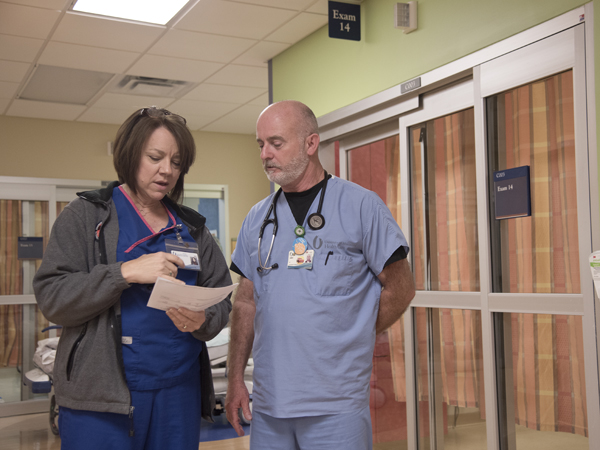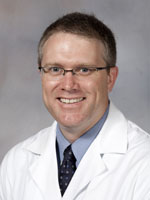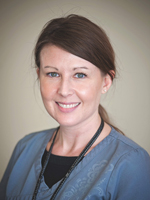Front-line caregivers keep patients safe

Published in News Stories on November 05, 2015
Since arriving last spring at the University of Mississippi Medical Center, Chief Medical Officer Dr. Michael Henderson has focused on a tough, yet achievable goal: Cutting patient harm events by half.
And as national watchdog groups and government agencies publicly scrutinize the Medical Center's safety record, Henderson has a message for front-line caregivers: The ball is in your court.

Henderson speaks to news media about the Medical Center's patient safety scores.
“I can't fix everything. They can fix it,” Henderson, a longtime transplant surgeon who now leads UMMC's quality performance program, told local media Monday during a news conference at the Medical Center. “My job is to make it easier for them. This is about engagement of the front-line workforce, and understanding what is really important for patients.”
The Medical Center's leadership offers no excuses for the recent Leapfrog hospital safety scorecard that gave UMMC an “F” rating for a number of patient safety categories in areas that include hospital acquired infection and post-surgery complications. What top leaders, including Henderson, do emphasize is the low ratings aren't an indication of failure, but instead a call for action.

Woodward
“UMMC is a safe hospital. Patients can and do come to us with confidence that we are on top of our game and that they will receive superb care,” said Dr. LouAnn Woodward, vice chancellor for health affairs and dean of the School of Medicine. “Are we perfect? We're not.
“Despite our very best efforts, we do occasionally make errors or oversights that could potentially expose patients to harm, as do all hospitals,” she said of the state's safety-net hospital and Mississippi's only Level 1 trauma center.
The recent scores are based on data that's up to three years old and doesn't reflect recent improvement. Even so, Henderson says, what's important is the hospital's safety performance now and in the future. “While UMMC has been making some improvement, we really need to accelerate the work so that every employee helps make our care for our patients as safe as possible,” he said.

Henderson speaks to news media about the Medical Center's patient safety scores.
“In a nutshell, on the hospital safety front the long-term goal is for zero preventable harm,” he said. “In practice, this means we have set specific targets in 2016 of cutting the number of hospital infections and patient safety indicators in half, and fully understanding our harm events by increasing their reporting and investigation.”
Department of Surgery Chair Dr. Christopher Anderson and his staff care daily for transplant patients and others who are among the sickest of the sick. “We all strive to take the best care possible of our patients,” he said.

Anderson
“With increased public scrutiny being placed on measurable quality metrics, we must both understand the metrics being measured and understand our role in improving the metrics at UMMC,” he said. “This includes everyone involved in the care team holding both themselves and those around them accountable.
“Everyone who works at UMMC is a caregiver, either directly or indirectly. It is important for all caregivers to embrace these metrics and be accountable for them, and we should not be intimidated by them as they fit into our daily care-delivery routine nicely.”

(From left) Registered nurses Carsyn Byars, Danny Smith and Kelly Green input information about patients being seen in the Pediatric Emergency Department.
UMMC caregivers should treat patients in regard to safety just as they would a family member, said Skye Stoker, nurse manager in the Batson Children's Hospital Emergency Department.
“One can walk on our unit at any given moment and hear staff speaking of patient care in terms of 'is this the standard we would expect for our own children, nieces and nephews, and how can we make this process better and improve our communication with this family,' ” Stoker said. “We all consider ourselves accountable for real-time feedback from our patients and their family members, and we strive to provide reassurance to families that we will follow up on their recommendations to improve our processes.”

Stoker
Patient safety, she said, is the top priority in the children's ED, and more than half of the staff has completed the Medical Center's required error prevention training. “Our team of over 100 nurses and providers are confident and empowered to take ownership of reporting near misses and at-risk events in real time,” Stoker said. “Our charge nurses submit snapshot reports every 12 hours to communicate challenges and opportunities.”
It furthers both transparency and accountability, Henderson said, to place the hospital's goals and in-house patient safety and harm data on the Medical Center's new clinical intranet for all caregivers to see.
“Who owns this and will make this happen? Everyone,” he said. “An important part of getting to highly reliable and safe health care is understanding how you can help achieve these goals. You know in your daily work what we need to do.”
While much remains to be done, Henderson said, the Medical Center's very recent improvement in patient safety scores from the federal Centers for Medicare and Medicaid Services shows progress is quite achievable. For 2014, the Medical Center was among about 25 percent of hospitals penalized for high patient harm events, with the sting being loss of 1 percent of their annual Medicare payments.
For 2015, however, the Medical Center's safety performance didn't warrant a penalty, Henderson said.
“The patient safety bar is set high, and it should be high,” Woodward said. “We welcome the transparency the government and outside ratings groups support. Transparency can be uncomfortable, but it will help all hospitals drive continued improvement.
“Our patients are the center of all that we do every day. Our leadership and staff are working very hard to provide them the best and safest care.”
Expect more external scrutiny of UMMC's safety performance based on available data, including that voluntarily reported by the Medical Center because its leaders choose to be transparent and accountable to patients and the public, Henderson said. “We will make the numbers better, but it's not just about the numbers,” he said. “It's about the patients, and giving them the best quality of care.”
“Our institutional goal to reduce measurable harm events by 50 percent over the next year is achievable. We can meet the metric, and it will help us in our goal to deliver the best care possible,” Anderson said.
Plain and simple, the quality of patient care provided by front-line staff, their attention to detail, and their willingness to embrace a shift to a culture of safety will shape the Medical Center's safety record.
“Stopping the line for safety and advocating for better care coordination is commonplace in our work unit,” Stoker said.
“Let's use the Leapfrog 'F' as a rallying point for the quality and safety goals that were already set, and show the world that UMMC is serious about demonstrating how much we care and how good we can be,” Henderson said.


